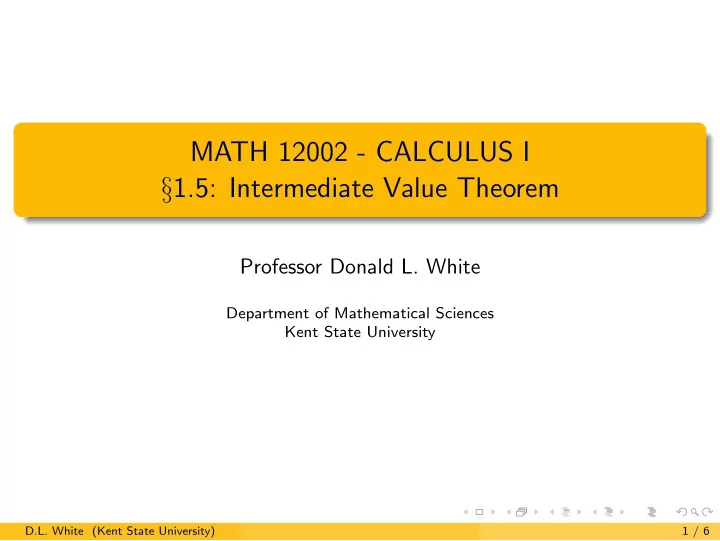

MATH 12002 - CALCULUS I § 1.5: Intermediate Value Theorem Professor Donald L. White Department of Mathematical Sciences Kent State University D.L. White (Kent State University) 1 / 6
Intermediate Value Theorem The Intermediate Value Theorem says that if a continuous function has two different y -values, then it takes on every y -value between those two values. The precise statement of the theorem is the following. Intermediate Value Theorem If y = f ( x ) is continuous on the interval [ a , b ] and N is any number strictly between f ( a ) and f ( b ) , then there is a number c, with a < c < b, such that f ( c ) = N. ✻ f ( b ) q f ( c ) = N N ✛ ✲ a c b f ( a ) q ❄ D.L. White (Kent State University) 2 / 6
Intermediate Value Theorem Alternatively, suppose we have two points in the xy -plane and we draw a horizontal line between them at y = N . In order to draw the graph of a continuous function y = f ( x ) between the points, we must cross the line y = N somewhere. The x -coordinate of the intersection point is the number c in the theorem. ✻ ✻ f ( b ) q q N N ✛ ✛ ✲ ✲ a a c b b f ( a ) q q ❄ ❄ D.L. White (Kent State University) 3 / 6
Finding Zeros Letting N = 0 in the IVT gives us the following special case. Corollary If y = f ( x ) is a continuous function and there are numbers a and b such that f ( a ) is positive and f ( b ) is negative, then there is a zero of f between a and b; that is, there is a c between a and b such that f ( c ) = 0 . D.L. White (Kent State University) 4 / 6
Finding Zeros The corollary can be used to approximate zeros of functions, as follows. Example Show that f ( x ) = x 3 + 3 x − 5 has a root between x = 1 and x = 2 and estimate the value of the root to within 0 . 01 . First observe that f is a polynomial, so is continuous everywhere, and that f (1) = 1 3 + 3(1) − 5 = − 1 < 0 and f (2) = 2 3 + 3(2) − 5 = 9 > 0. By the Corollary, there is a number c , 1 < c < 2, such that f ( c ) = 0. Now compute the value of f for a number between 1 and 2; say f (1 . 5). If f (1 . 5) > 0, then f has a root between x = 1 and x = 1 . 5. If f (1 . 5) < 0, then f has a root between x = 1 . 5 and x = 2. Check that f (1 . 5) = 2 . 875 is positive. Since f (1) is negative, there is a root between 1 and 1 . 5. [Continued → ] D.L. White (Kent State University) 5 / 6
Finding Zeros Now f (1 . 2) = 0 . 328 is also positive. Again, f (1) is negative, so there is a root between 1 and 1 . 2. Continue this way: f (1 . 1) = − 0 . 369 is negative and f (1 . 2) is positive ⇒ root in (1 . 1 , 1 . 2). f (1 . 15) ≈ − 0 . 029 is negative and f (1 . 2) is positive ⇒ root in (1 . 15 , 1 . 2). f (1 . 18) ≈ 0 . 183 is positive and f (1 . 15) is negative ⇒ root in (1 . 15 , 1 . 18). f (1 . 16) ≈ 0 . 041 is positive and f (1 . 15) is negative ⇒ root in (1 . 15 , 1 . 16). Therefore, we know that f has a root in the interval (1 . 15 , 1 . 16), which has length 0 . 01. NOTE: Continuing this method, you can show that the root is between 1 . 1541714951 and 1 . 1541714952. D.L. White (Kent State University) 6 / 6
Recommend
More recommend